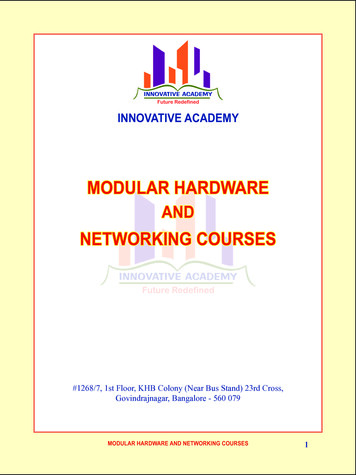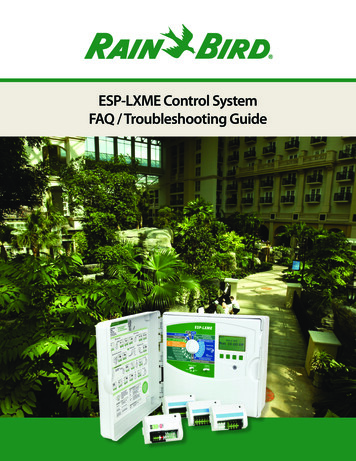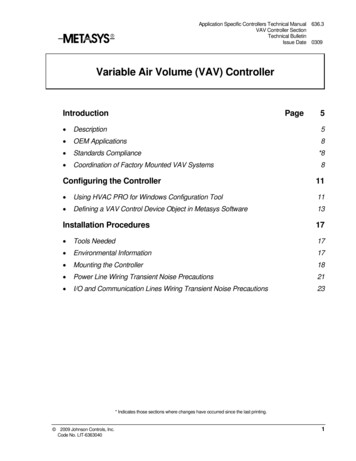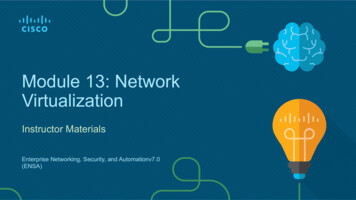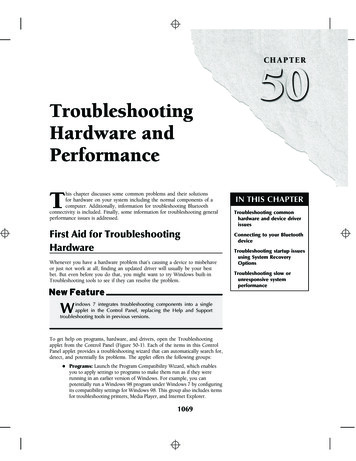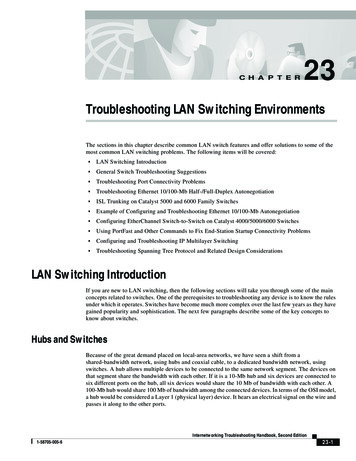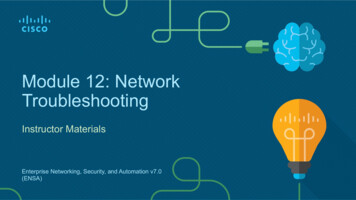
Transcription
Module 12: NetworkTroubleshootingInstructor MaterialsEnterprise Networking, Security, and Automation v7.0(ENSA)
Module 12: NetworkTroubleshootingEnterprise Networking, Security, and Automation v7.0(ENSA)
Module ObjectivesModule Title: Network TroubleshootingModule Objective: Troubleshoot enterprise networks.Topic TitleNetwork DocumentationTopic ObjectiveExplain how network documentation is developedand used to troubleshoot network issues.Troubleshooting ProcessCompare troubleshooting methods that use asystematic, layered approach.Troubleshooting ToolsDescribe different networking troubleshooting tools.Symptoms and Causes of Network ProblemsDetermine the symptoms and causes of networkproblems using a layered model.Troubleshooting IP ConnectivityTroubleshoot a network using the layered model. 2012 Cisco and/or its affiliates. All rights reserved. Cisco Confidential11
12.1 Network Documentation 2012 Cisco and/or its affiliates. All rights reserved. Cisco Confidential12
Network DocumentationDocumentation OverviewAccurate and complete network documentation is required to effectively monitor andtroubleshoot networks.Common network documentation includes the following: Physical and logical network topology diagrams Network device documentation that records all pertinent device informationNetwork performance baseline documentationAll network documentation should be kept in a single location and backup documentationshould be maintained and kept in a separate location. 2012 Cisco and/or its affiliates. All rights reserved. Cisco Confidential13
Network DocumentationNetwork Topology DiagramsThere are two types of network topology diagrams: physical and logical.Physical TopologyLogical Topology 2012 Cisco and/or its affiliates. All rights reserved. Cisco Confidential14
Network DocumentationNetwork Device DocumentationNetwork devicedocumentation shouldcontain accurate, up-todate records of thenetwork hardware andsoftware.Documentation shouldinclude all pertinentinformation about thenetwork devices.Router DeviceDocumentationSwitch DeviceDocumentationEnd-SystemDocumentation 2012 Cisco and/or its affiliates. All rights reserved. Cisco Confidential15
Network DocumentationEstablish a Network BaselineA network baseline is used to establish normal network performance to determine the“personality” of a network under normal conditions. Establishing a network performancebaseline requires collecting performance data from the ports and devices that areessential to network operation.The baseline data is as follows: Provides insight into whether the current network design can meet businessrequirements. Can reveal areas of congestion or areas in the network that are underutilized. 2012 Cisco and/or its affiliates. All rights reserved. Cisco Confidential16
Network DocumentationStep 1 - Determine What Types of Data to CollectWhen conducting the initial baseline, start by selecting a few variables that represent thedefined policies.If too many data points are selected, the amount of data can be overwhelming, makinganalysis of the collected data difficult.Start out simply and fine-tune along the way.Some good starting variables are interface utilization and CPU utilization. 2012 Cisco and/or its affiliates. All rights reserved. Cisco Confidential17
Network DocumentationStep 2 - Identify Devices and Ports of InterestA logical network topology can be useful inidentifying key devices and ports to monitor.As shown in the sample topology, thedevices and ports of interest include: PC1 (the Admin terminal) Two servers (i.e., Srv1 and Svr2) Router interfaces Key ports on switches 2012 Cisco and/or its affiliates. All rights reserved. Cisco Confidential18
Network DocumentationStep 3 - Determine the Baseline DurationWhen capturing data for analysis, the period specified should be: At a minimum, seven days long. Last no more than six weeks, unless specific long-term trends need to be measured. Generally, a two-to-four-week baseline is adequate.Conduct an annual analysis of the entire network, or baseline different sections of thenetwork on a rotating basis.Analysis must be conducted regularly to understand how the network is affected bygrowth and other changes. 2012 Cisco and/or its affiliates. All rights reserved. Cisco Confidential19
Network DocumentationData MeasurementThe table lists some of the most common Cisco IOS commands used for data collection.CommandDescriptionshow version Displays uptime, version information for device software and hardwareshow ip interface [brief]show ipv6 interface [brief] Displays all the configuration options that are set on an interface.show interfaces Displays detailed output for each interface.show ip route [static eigrp ospf bgp]show ipv6 route [static eigrp ospf bgp] Displays the routing table content listing directly connected networks andlearned remote networks.show cdp neighbors detail Displays detailed information about directly connected Cisco devices.show arpshow ipv6 neighbors Displays the contents of the ARP table (IPv4) and the neighbor table (IPv6).show running-config Displays current configuration.show vlan Displays the status of VLANs on a switch.show port Displays the status of ports on a switch.show tech-support Used to collect a large amount of information using multiple show commandsfor technical support reporting purposes. 2012 Cisco and/or its affiliates. All rights reserved. Cisco Confidential20
12.2 TroubleshootingProcess 2012 Cisco and/or its affiliates. All rights reserved. Cisco Confidential21
Troubleshooting ProcessGeneral Troubleshooting ProceduresTroubleshooting can be time consumingbecause networks differ, problems differ, andtroubleshooting experience varies. Using a structured troubleshooting methodwill shorten overall troubleshooting time. There are several troubleshootingprocesses that can be used to solve aproblem. The figure displays the logic flowchart of asimplified three-stage troubleshootingprocess. 2012 Cisco and/or its affiliates. All rights reserved. Cisco Confidential22
Troubleshooting ProcessSeven-Step Troubleshooting ProcessThe figure displays a more detailed sevenstep troubleshooting process.StepsDescriptionDefine the Problem Verify that there is a problem and then properly define what the problem is.Gather Information Targets (i.e., hosts, devices) are identified, accessed, and information gathered.Analyze Information Identify possible causes using network documentation, network baselines, knowledge bases, and peers.Eliminate PossibleCauses Progressively eliminate possible causes to eventually identify the most probable cause.Propose Hypothesis When the most probable cause has been identified, a solution must be formulated.Test Hypothesis Assess the urgency of the problem, create a rollback plan, implement the solution, and verify outcome.Solve the Problem When solved, inform all involved and document the cause and solution to help solve future problems. 2012 Cisco and/or its affiliates. All rights reserved. Cisco Confidential23
Troubleshooting ProcessQuestion End UsersThe table provides questioning guidelines and sample open ended end-user questions.GuidelinesExample Open Ended End-User QuestionsAsk pertinent questions. What does not work? What exactly is the problem? What are you trying to accomplish?Determine the scope of the problem. Who does this issue affect? Is it just you or others? What device is this happening on?Determine when the problem occurred /occurs. When exactly does the problem occur? When was the problem first noticed? Were there any error message(s) displayed?Determine if the problem is constant orintermittent. Can you reproduce the problem? Can you send me a screenshot or video of the problem?Determine if anything has changed. What has changed since the last time it did work?Use questions to eliminate or discoverpossible problems. What works? What does not work? 2012 Cisco and/or its affiliates. All rights reserved. Cisco Confidential24
Troubleshooting ProcessGather InformationCommon Cisco IOS commands used to gather network problem symptoms.CommandDescriptionping {host ip-address} Sends an echo request packet to an address, then waits for a reply.traceroute destination Identifies the path a packet takes through the networks.telnet {host ip-address} Connects to an IP address using the Telnet application (Note: Use SSH whenever possible).ssh -l user-id ip-address Connects to an IP address using SSH.show ip interface briefshow ipv6 interface brief Displays a summary status of all interfaces on a device.show ip routeshow ipv6 route Displays the current IPv4 and IPv6 routing tables.show protocols Displays the global and interface-specific status of any configured Layer 3 protocol.debug Displays a list of options for enabling or disabling debugging events. 2012 Cisco and/or its affiliates. All rights reserved. Cisco Confidential25
Troubleshooting ProcessTroubleshooting with Layered ModelsThe OSI and TCP/IP models can be applied to isolate network problems whentroubleshooting.The figure shows some commondevices and the OSI layers thatmust be examined during thetroubleshooting process for thatdevice. 2012 Cisco and/or its affiliates. All rights reserved. Cisco Confidential26
Troubleshooting ProcessStructured Troubleshooting MethodsDifferent troubleshooting approaches that can be used include the -Up Good approach to use when the problem is suspected to be a physical one.Top-Down Use this approach for simpler problems, or when you think the problem is with a piece of software.Divide-and-Conquer Start at a middle layer (i.e, Layer 3) and tests in both directions from that layer.Follow-the-Path Used to discover the actual traffic path from source to destination to reduce the scope of troubleshooting.Substitution You physically swap a suspected problematic device with a known, working one.Comparison Attempts to resolve the problem by comparing a nonoperational element with the working one.Educated guess Success of this method varies based on your troubleshooting experience and ability. 2012 Cisco and/or its affiliates. All rights reserved. Cisco Confidential27
Troubleshooting ProcessGuidelines for Selecting a Troubleshooting MethodTo quickly resolve network problems, take thetime to select the most effective networktroubleshooting method. The figure illustrates which method could beused when a certain type of problem isdiscovered.Troubleshooting is a skill that is developed bydoing it.Every network problem you identify and solvegets added to your skill set. 2012 Cisco and/or its affiliates. All rights reserved. Cisco Confidential28
12.3 TroubleshootingProcess 2012 Cisco and/or its affiliates. All rights reserved. Cisco Confidential29
Troubleshooting ToolsSoftware Troubleshooting ToolsCommon software troubleshooting tools include the following:Software ToolDescriptionNetwork ManagementSystem Tools Network software include device-level monitoring, configuration, and fault-management tools. Tools can be used to investigate and correct network problems.Knowledge Bases Online network device vendor knowledge bases have become indispensable sources of information. When vendor-based knowledge bases are combined with internet search engines, a network administratorhas access to a vast pool of experience-based information.Baselining Tools Many tools for automating the network documentation and baselining process are available. Baselining tools help with common documentation tasks such as network diagrams, update networksoftware and hardware documentation, and cost-effectively measure baseline network bandwidth use. 2012 Cisco and/or its affiliates. All rights reserved. Cisco Confidential30
Troubleshooting ToolsProtocol AnalyzersA protocol analyzer cancapture and display thephysical layer to theapplication layer informationcontained in a packet.Protocol analyzers, such asWireshark, can helptroubleshoot networkperformance problems. 2012 Cisco and/or its affiliates. All rights reserved. Cisco Confidential31
Troubleshooting ToolsHardware Troubleshooting ToolsThere are multiple types of hardware troubleshooting tools.Hardware ToolsDescriptionDigital MultimetersDevices measure electrical values of voltage, current, and resistance.Cable TestersHandheld devices are designed for testing the various types of data communication cabling.Cable AnalyzersMultifunctional handheld devices used to test and certify copper and fiber cables.Portable NetworkAnalyzersSpecialized device used for troubleshooting switched networks and VLANs.Cisco Prime NAMBrowser-based interface that displays device performance analysis in a switched and routed environment. 2012 Cisco and/or its affiliates. All rights reserved. Cisco Confidential32
Troubleshooting ToolsSyslog Server as a Troubleshooting ToolSyslog is used by syslog clients to send text-based log messages to a syslog server. Log messages can be sent to the console, VTY lines, memorybuffer, or syslog server.Cisco IOS log messages fall into one of eight levels.The lower the level number, the higher the severity level.By default, the console displays level 6 (debugging) messages.In the command output, level 0 (emergencies) to 5 (notifications)are sent to the syslog server at 7Debugging 2012 Cisco and/or its affiliates. All rights reserved. Cisco Confidential33
12.4 Symptoms and Causesof Network Problems 2012 Cisco and/or its affiliates. All rights reserved. Cisco Confidential34
Symptoms and Causes of Network ProblemsPhysical Layer TroubleshootingThe table lists common symptoms of physical layer network problems.SymptomDescriptionPerformance lowerthan baseline Requires previous baselines for comparison. The most common reasons include overloaded or underpowered servers, unsuitable switch or routerconfigurations, traffic congestion on a low-capacity link, and chronic frame loss.Loss of connectivity Loss of connectivity could be due to a failed or disconnected cable. Can be verified using a simple ping test. Intermittent connectivity loss can indicate a loose or oxidized connection.Network bottlenecksor congestion If a route fails, routing protocols could redirect traffic to sub-optimal routes. This can result in congestion or bottlenecks in parts of the network.High CPU utilizationrates High CPU utilization rates indicates that a device is operating at or exceeding its design limits. If not addressed quickly, CPU overloading can cause a device to shut down or fail.Console errormessages Error messages reported on the device console could indicate a physical layer problem. Console messages should be logged to a central syslog server. 2012 Cisco and/or its affiliates. All rights reserved. Cisco Confidential35
Symptoms and Causes of Network ProblemsPhysical Layer Troubleshooting (Cont.)The table lists issues that commonly cause network problems at the physical layer.Problem CauseDescriptionPower-relatedCheck the operation of the fans and ensure that the chassis intake and exhaust vents are clear.Hardware faultsFaulty or corrupt NIC driver files, bad cabling, or grounding problems can cause network transmissionerrors such as late collisions, short frames, and jabber.Cabling faultsLook for damaged cables, improper cable, and poorly crimped connectors.Suspect cables should be tested or exchanged with a known functioning cable.AttenuationAttenuation can be caused if a cable length exceeds the design limit for the media, or when there is apoor connection resulting from a loose cable, or dirty or oxidized contacts.NoiseLocal electromagnetic interference (EMI) can be generated by many sources, such as crosstalk,nearby electric cables, large electric motors, FM radio stations, police radio, and more.Interface configuration Causes can include incorrect clock rate, incorrect clock source, and interface not being turned on.errorsThis causes a loss of connectivity with attached network segments.Exceeding designlimitsA component could operate sub-optimally if it is being utilized beyond specifications.CPU overloadSymptoms include processes with high CPU utilization percentages, input queue drops, slowperformance, SNMP timeouts, no remote access, no DHCP services, Telnet, and pings are slow or failto respond. 2012 Cisco and/or its affiliates. All rights reserved. Cisco Confidential36
Symptoms and Causes of Network ProblemsData Link Layer TroubleshootingThe table lists common symptoms of data link layer network problems.SymptomDescriptionNo functionality or connectivityat the network layer or aboveSome Layer 2 problems can stop the exchange of frames across a link, while others onlycause network performance to degrade.Network is operating belowbaseline performance levels Frames can take a suboptimal path to their destination but still arrive causing the networkto experience unexpected high-bandwidth usage on links. An extended or continuous ping can help reveal if frames are being dropped.Excessive broadcasts Operating systems use broadcasts and multicasts extensively. Generally, excessive broadcasts are the result of a poorly programmed or configuredapplications, a large Layer 2 broadcast domains, or an underlying network problems .Console messages Routers send messages when it detects a problem with interpreting incoming frames(encapsulation or framing problems) or when keepalives are expected but do not arrive. The most common console message that indicates a Layer 2 problem is a line protocoldown message 2012 Cisco and/or its affiliates. All rights reserved. Cisco Confidential37
Symptoms and Causes of Network ProblemsData Link Layer TroubleshootingThe table lists issues that commonly cause network problems at the data link layer.Problem CauseDescriptionEncapsulation errorsOccurs when bits placed in a field by the sender are not what the receiverexpects to see.Occurs when Layer 2 and Layer addressing is not available.Address mappingerrorsFraming errorsSTP failures or loopsFraming errors can be caused by a noisy serial line, an improperly designedcable, faulty NIC, duplex mismatch, or an incorrectly configured channelservice unit (CSU) line clock.Most STP problems are related to forwarding loops that occur when no portsin a redundant topology are blocked and traffic is forwarded in circlesindefinitely, excessive flooding because of a high rate of STP topologychanges. 2012 Cisco and/or its affiliates. All rights reserved. Cisco Confidential38
Symptoms and Causes of Network ProblemsNetwork Layer TroubleshootingThe table lists common symptoms of network layer network problems.SymptomDescriptionNetwork failure Occurs when the network is nearly or completely non-functional, affecting allusers and applications on the network. These failures are usually noticed quickly by users and network administratorsand are obviously critical to the productivity of a company.Suboptimal performance These involve a subset of users, applications, destinations, or a type of traffic. Optimization issues can be difficult to detect and even harder to isolate anddiagnose. This is because they usually involve multiple layers, or even a single hostcomputer. Determining that the problem is a network layer problem can take time. 2012 Cisco and/or its affiliates. All rights reserved. Cisco Confidential39
Symptoms and Causes of Network ProblemsNetwork Layer Troubleshooting (Cont.)The table lists common symptoms of network layer network problems.Problem CauseDescriptionGeneral network issues Often a change in the topology may unknowingly have effects on other areasof the network. Determine whether anything in the network has recently changed, and ifthere is anyone currently working on the network infrastructure.Connectivity issuesCheck for any equipment and connectivity problems, including powerproblems, environmental problems, and Layer 1 problems, such as cablingproblems, bad ports, and ISP problems.Routing tableCheck the routing table for anything unexpected, such as missing routes orunexpected routes.Neighbor issuesCheck to see if there are any problems with the routers forming neighboradjacencies.Topology databaseCheck the table for anything unexpected, such as missing entries or 2012 Cisco and/or its affiliates. All rights reserved. Cisco Confidentialunexpected entries.40
Symptoms and Causes of Network ProblemsTransport Layer Troubleshooting - ACLsThe table lists areas where ACL misconfigurations commonly occur.MisconfigurationsDescriptionSelection of traffic flowAn ACL must be applied to the correct interface in the correct traffic direction.Order of access control entriesThe entries in an ACL should be from specific to general.Implicit deny anyThe implicit ACE can be the cause of an ACL misconfiguration.Addresses and IPv4 wildcard masksComplex IPv4 wildcard masks are more efficient, but are more subject toconfiguration errors.Selection of transport layer protocol It is important that only the correct transport layer protocol be specified in an ACE.Source and destination portsEnsuring that the correct inbound and outbound ports are specified in an ACEUse of the established keywordThe established keyword applied incorrectly, can provide unexpected results.Uncommon protocolsMisconfigured ACLs often cause problems for protocols other than TCP and UDP. 2012 Cisco and/or its affiliates. All rights reserved. Cisco Confidential41
Symptoms and Causes of Network ProblemsTransport Layer Troubleshooting - NAT for IPv4The table lists common interoperability areas with NAT.SymptomDescriptionBOOTP and DHCP The DHCP-Request packet has a source IPv4 address of 0.0.0.0. However, NAT requires both a valid destination and source IPv4 address,therefore, BOOTP and DHCP can have difficulty operating over a router runningeither static or dynamic NAT. Configuring the IPv4 helper feature can help solve this problem.DNS A DNS server outside the NAT router does not have an accurate representation ofthe network inside the router. Configuring the IPv4 helper feature can help solve this problem.SNMP An SNMP management station on one side of a NAT router may not be able tocontact SNMP agents on the other side of the NAT router. Configuring the IPv4 helper feature can help solve this problem.Tunneling and encryption protocolsEncryption and tunneling protocols often require that traffic be sourced from aspecific UDP or TCP port, or use a protocol at the transport layer that cannot beprocessed by NAT. 2012 Cisco and/or its affiliates. All rights reserved. Cisco Confidential42
Symptoms and Causes of Network ProblemsApplication Layer TroubleshootingThe table provides a short description of these application layer protocols.ApplicationsDescriptionSSH/TelnetEnables users to establish terminal session connections with remote hosts.HTTPSupports the exchanging of text, graphic images, sound, video, and other multimedia files on theweb.FTPPerforms interactive file transfers between hosts.TFTPPerforms basic interactive file transfers typically between hosts and networking devices.SMTPSupports basic message delivery services.POPConnects to mail servers and downloads email.SNMPCollects management information from network devices.DNSMaps IP addresses to the names assigned to network devices.NFSNetwork File System (NFS) enables computers to mount and use drives on remote hosts. 2012 Cisco and/or its affiliates. All rights reserved. Cisco Confidential43
12.5 Troubleshooting IPConnectivity 2012 Cisco and/or its affiliates. All rights reserved. Cisco Confidential44
Troubleshooting IP ConnectivityComponents of Troubleshooting End-to-End ConnectivityBottom-up approach steps when there is no end-to-end connectivity are as follows:1. Check physical connectivity at the point where network communication stops.2. Check for duplex mismatches.3. Check data link and network layer addressing on the local network.4. Verify that the default gateway is correct.5. Ensure that devices are determining the correct path from the source to thedestination.6. Verify the transport layer is functioning properly.7. Verify that there are no ACLs blocking traffic.8. Ensure that DNS settings are correct. 2012 Cisco and/or its affiliates. All rights reserved. Cisco Confidential45
Troubleshooting IP ConnectivityEnd-to-End Connectivity Problem Initiates TroubleshootingUsually what initiates a troubleshootingeffort is the discovery that there is aproblem with end-to-end connectivity.Two of the most common utilities usedto verify a problem with end-to-endconnectivity are ping and traceroute. 2012 Cisco and/or its affiliates. All rights reserved. Cisco Confidential46
Troubleshooting IP ConnectivityStep 1 - Verify the Physical LayerThe show interfaces command is usefulwhen troubleshooting performancerelated issues and hardware is suspectedto be at fault.Of interest in the output are the: Interface status Input queue drops Output queue drops Input errors Output errors 2012 Cisco and/or its affiliates. All rights reserved. Cisco Confidential47
Troubleshooting IP ConnectivityStep 2 - Check for Duplex MismatchesThe IEEE 802.3ab Gigabit Ethernet standard mandates the use of autonegotiation forspeed and duplex and practically all Fast Ethernet NICs also use autonegotiation bydefault.Problems can occur when there is a duplex mismatch. 2012 Cisco and/or its affiliates. All rights reserved. Cisco Confidential48
Troubleshooting IP ConnectivityStep 3 - Verify Addressing on the Local NetworkThe arp Windows command displays and modifies entries in the ARP cache that are usedto store IPv4 addresses and their resolved Ethernet physical (MAC) addresses. 2012 Cisco and/or its affiliates. All rights reserved. Cisco Confidential49
Troubleshooting IP ConnectivityTroubleshoot VLAN Assignment ExampleAnother issue to consider when troubleshooting end-to-end connectivity is VLANassignment.For example, the MAC address on Fa0/1 shouldbe in VLAN 10 instead of VLAN 1.The following configuration changes Fa0/1 toVLAN 10 and verifies the change. 2012 Cisco and/or its affiliates. All rights reserved. Cisco Confidential50
Troubleshooting IP ConnectivityStep 4 - Verify Default GatewayMisconfigured or missing default gateways can cause connectivity problems.In the figure for example, the defaultgateways for: R1 is 192.168.1.2 (R2) PC1 is 10.1.10.1 (R1 G0/0/0)Useful commands to verify the defaultgateway on: R1: show ip route PC1: route print (or netstat –r) 2012 Cisco and/or its affiliates. All rights reserved. Cisco Confidential51
Troubleshooting IP ConnectivityTroubleshoot IPv6 Default Gateway ExampleAn IPv6default gateway can be configured manually, using SLAAC, or by using DHCPv6.For example, a PC is unable to acquire its IPv6configuration using SLAAC. The commandoutput is missing the all IPv6-router multicastgroup (FF02::2).R1 is enabled as an IPv6 router and now theoutput verifies that R1 is a member of ff02::2,the All-IPv6-Routers multicast group. 2012 Cisco and/or its affiliates. All rights reserved. Cisco Confidential52
Troubleshooting IP ConnectivityStep 5 - Verify Correct PathWhen troubleshooting, it is often necessary to verify the path to the destination network. The figure describes the process forboth the IPv4 and IPv6 routing tables.The process of forwarding IPv4 andIPv6 packets is based on the longest bitmatch or longest prefix match.The routing table process will attempt toforward the packet using an entry in therouting table with the greatest numberof leftmost matching bits.The number of matching bits isindicated by the prefix length of theroute. 2012 Cisco and/or its affiliates. All rights reserved. Cisco Confidential53
Troubleshooting IP ConnectivityStep 6 - Verify the Transport LayerTwo of the most common issues that affect transport layer connectivity include ACLconfigurations and NAT configurations. A common tool for testing transport layer functionality is the Telnet utility. For example, the administrator attempts to Telnet to R2 using port 80. 2012 Cisco and/or its affiliates. All rights reserved. Cisco Confidential54
Troubleshooting IP ConnectivityStep 7 - Verify ACLsOn routers, there may be ACLs that prohibit protocols from passing through the interfacein the inbound or outbound direction.In this example, ACL 100 has been incorrectlyconfigured inbound on the G0/0/0 instead ofinbound on S0/1/1.The ACL is removed from G0/0/0 andconfigured inbound on S0/1/1. 2012 Cisco and/or its affiliates. All rights reserved. Cisco Confidential55
Troubleshooting IP ConnectivityStep 8 - Verify DNSThe DNS protocol controls the DNS, a distributed database with which you can maphostnames to IP addresses. When you configure DNS on the device, you can substitute the hostname for the IPaddress with all IP commands, such as ping or telnet. command output. Use the ip host global configurationcommand to enter a name to be usedinstead of the IPv4 address of the switchor router, as shown in the commandoutput. Use the nslookup Windows command todisplay the name-to-IP-address mappinginformation. 2012 Cisco and/or its affiliates. All rights reserved. Cisco Confidential56
Troubleshooting IP ConnectivityPacket Tracer - Troubleshoot Enterprise NetworksIn this Packet Tracer activity, you complete the following objectives: Part 1: Verify Switching Technologies Part 2: Verify DHCP Part 3: Verify Routing Part 4: Verify WAN Technologies Part 5: Verify Connectivity 2012 Cisco and/or its affiliates. All rights reserved. Cisco Confidential57
12.6 Module Practice and Quiz 2012 Cisco and/or its affiliates. All rights reserved. Cisco Confidential58
Structured DesignPacke
Cisco Confidential 13 Network Documentation Documentation Overview Accurate and complete network documentation is required to effectively monitor and troubleshoot networks. Common network documentation includes the following: Physical and logical network topology diagrams Network device documentation that records all pertinent device .
